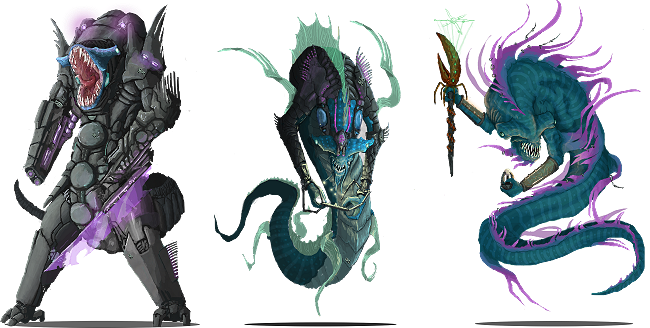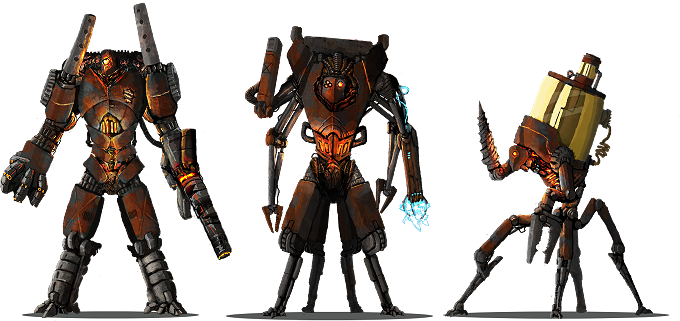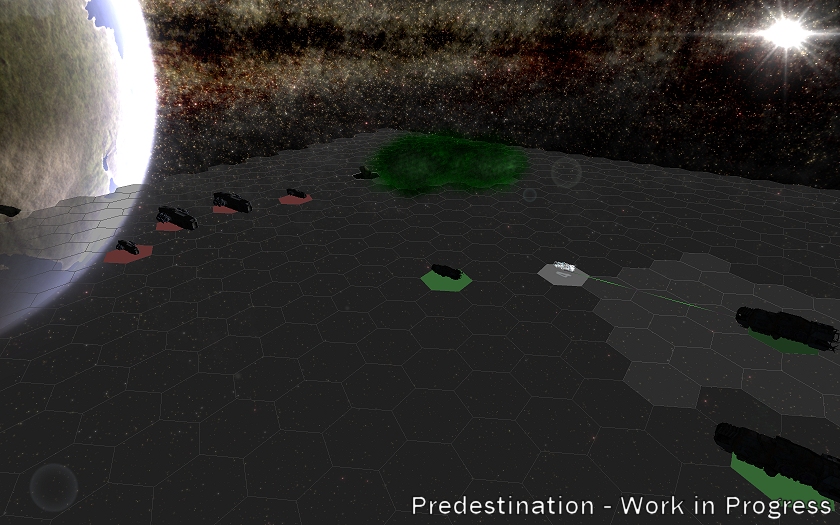April is over and development on Predestination is going well. This month we completed the internal workings for the ship design and weapon technology systems, finished hooking the tactical combat system into the main game and tidied that system up. We implemented tons of your ideas into the ship combat system, like smart-missiles that deploy mines around the target, weapons that fire clouds of charged plasma, and deployable minefields for planet defense. Thanks so much for all of your great ideas and feedback!
Character artist Connor Murphy has finished our final core race (the yet-to-be-named Aquatic race) and completed a fantastic visual reboot of our first robotic race, The Starforged. You can see the new artwork for both races below! We’ve also been working with Connor on figuring out the best way to approach the backer-sponsored race artwork.
Based on your feedback, Connor has already started to revamp the feline race we showed in last month’s update with more realistic artwork that matches the rest of the game’s visual style, and I think you’ll be pleased with the results when it’s finished. Once that’s finished, we’ll be in touch with all of our race designer backers to get started on getting them into the game.
The yet-to-be-named Aquatics are our sixth and final core race apart from the backer races, and we’d love to hear your ideas on what they should be like in-game. We see them as aggressive militarists who see ownership of every ocean planet in the galaxy as their sovereign right. We see them as a dictatorship that interacts with other races through intimidation and military threat more than diplomacy. Industry and research would probably take a hit from working under water, but their natural hunting instincts would make them excellent ship pilots.
The Aquatic race will definitely start the game with some kind of mech suit that grants bonuses to ground combat, as they needed this technology to achieve space flight and interact with other races. They are just as at-home on Terran planets as Ocean, but would probably actively flood Terran worlds to make them less useful to other races. They may also have developed technology that can thaw out a tundra planet by injecting radioactive elements into the planet’s core and flooding the atmosphere with greenhouse gases.
Rather than deciding on the race’s abilities and name ourselves, we’ve decided to open the Aquatics up to the community! We’d love to hear your suggestions for a name for this race, stats or traits you think they should have, and any special technologies they should start with. We’d also love to hear your ideas on what technologies and special traits you’d like all aquatic races in Predestination to have. Leave a comment here or head over to the aquatic race feedback thread on the forum and let us know what you think! We’ll publish a full race reveal in two week’s time when we’ve picked our favourite suggestions!
Above is the rebooted artwork for The Starforged, the first race we revealed during the Kickstarter campaign. Connor felt that the art needed an update to match the visual quality of newer races like the Sauros, and I think he’s done an amazing job on the reboot. The Starforged soldier unit is on the left, the scientist is in the middle, and the worker/civilian robot is on the right. We’ve nicknamed the worker the “Espresso machine” 😀
Combat resolution: One of the things we implemented this month was the combat resolution system that decides when fights happen and what the battlefield looks like. Fleets in Predestination move in FTL once per turn and only meet each other at destinations like stars and temporal rifts. When two fleets meet, both players can select from four courses of action and the combination of options selected determines what happens:
- Attack Planet: Attempt to attack a selected enemy planet in the system. The enemy must have a planet in the system for this option to be highlighted. You start on one side of the battlefield, and the enemy planet is visible in the background on the other side. Planetary defences like starbases and orbital cannons are automatically placed on the enemy side.
- Defend: This puts your fleet into a defensive posture and does not engage the enemy fleet. If the enemy fleet selects to attack a planet in the system that you own, your fleet automatically defends that planet and is included in the combat against that planet.
- Intercept: Attempts to intercept the enemy fleet early and engage. If the enemy fleet selects Attack a planet, this option will instead engage the enemy in open space (no planet bonuses). If the enemy fleet selects to Defend, there’s a 50% chance that you’ll catch them in open space and start combat and a 50% chance that no combat will happen at all.
- Retreat: Attempts to retreat and set course to the nearest friendly star system. If the enemy fleet selects the Intercept option, there’s a 50% chance of catching your fleet and beginning combat in open space and a 50% chance they get away safely.
Battlefield generation: The battlefield will now take into account the star system you’re in. Battles in systems with asteroid belts are likely to take place inside the belt, while battles inside a nebula will be filled with nebular gas clouds. Battles over a planet will also display the planet in the background behind the defending fleet, and orbital cannons and starbases will be placed on the battlefield.
We have a few more ideas up our sleeves for more natural battlefield modifiers, like pirate hideouts in a system or even space monsters interrupting your battle! The battlefield size will also scale up with the number of ships involved and the maximum range of the ships involved. This way every battle will start with the opposing fleets placed between one and two turns worth of movement away from each other. This should stop snipers from dominating as nobody will be in range to fire on the first round.
Ship placement round: Before each combat begins, you’ll place your ships and structures on the battlefield. We plan to make it possible to pre-design a layout and save it with your fleet for future battles, but right now that feature is not implemented. Battles in orbit of a planet will have starbases and orbital cannons in fixed positions if the planet has built them. Researchable technologies will also add deployables like mine fields, shield bubbles, cloaking fields and nebulae so you can come up with a clever strategy for system defense and design your ships around them. The ship placement phase is a blind phase, so you don’t know where the enemy has placed his ships or structures until you submit your layout. Think of this like setting up a chess board, except you get to decide where each piece goes.
First combat round: The first round of combat after placing ships in Predestination will be mostly movement. The longest-range ships will not be in firing range of the enemy fleet yet; missiles and drones can be fired but will take at least two turns to reach the enemy. This lets you set up strategic positioning to counter the enemy’s selected fleet layout. For example, you may notice that the enemy has laid a minefield in front of its snipers and decide to send ships around the side to avoid them.
The rest of the combat: The player’s and enemy’s ships will will take turns as usual for the rest of the game, like a game of chess where each move is a reaction to the other player’s. For example, the enemy may fire missiles at your large battleship and you may move some point defense frigates into positions where they can shoot down the missiles. Combat ends when all of one side’s ships have been eliminated or are no longer on the battlefield. Ships can retreat at any time during the battle by activating the Warp Drive module (built into all ships). This has a charge-up time of one full round, making the ship leave the battlefield on its next turn.
We’ve been working on a lot of the core planetary and fleet combat code of Predestination so far, but it’s difficult to show off interesting ship weapons or galactic exploration without a good user interface. The next step for us is to work really hard on those user interfaces and get as many of them into the game this month as possible. As a side-effect, we’ll be able to show you more of our progress in videos and live demos, giving a clearer impression of how the game will actually play when it’s finished.
So far we’ve focused on trying to put together one big monthly update for our Kickstarter backers and fans following the Predestination development blog. We’re doing a lot of work steadily throughout the month but then trying to cram it all into one roundup article like this or a race reveal post. We’ve had a few requests from backers for more frequent updates and more community engagement, so I wanted to put this question out to the community. Would you like to see more frequent updates containing earlier work-in-progress artwork, game development, user interfaces, buildings etc? Our options are essentially:
- Monthly updates: One big update every month summarising that month’s progress (like this post).
- Frequent updates: Posting early work-in-progress artwork, buildings, gameplay and user interfaces separately with just a few lines or paragraphs of text explaining each one.
- Both: Do the smaller updates, and then summarise them each month in a smaller roundup article on the blog and Kickstarter.
We’d love to start doing more frequent updates if that’s what the community wants. The updates would be a lot more rough and subject to change, but it would let us collect feedback earlier in the development process. Please let us know in the comments or head over to the official update poll on the forum and vote!
Cheers,
— Brendan, Lead Developer











